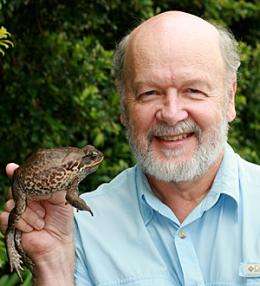Professor Rick Shine: "This is the first powerful tool we have created to control cane toads."
(Phys.org) -- An effective new weapon in the fight against the spread of cane toads has been developed by the University of Sydney, in collaboration with the University of Queensland.
"This is the first powerful tool we have created to control cane toads," said Professor Rick Shine, from the University's School of Biological Sciences and the lead author of the study which is published in the Proceedings of Royal Society B on Wednesday 13 June.
The new research shows that the same powerful poisons cane toads use to devastate native species can be used as a weapon against the toads themselves - by using the poison as 'bait' in traps set in waterbodies to catch toad tadpoles.
"A chemical 'bait' created from the toads' poison is a real magnet for toad tadpoles," Professor Shine said.
The biggest obstacle to getting rid of cane toads is that a single clutch (the amount of eggs laid at a time by one female) can contain more than 30,000 eggs.
"This means that even if you catch and kill 99 percent of the adult toads in an area, the few that are left can produce so many offspring that before you know it you are back to where you started - just as many cane toads as ever," Professor Shine said.
The only way around the problem is to stop the toads from reproducing, Professor Shine explains.
The study discovered the secretion from the shoulder (parotoid) glands of dead toads can be used as bait. It is cheap, easy to obtain and highly attractive to toad tadpoles - but repels the tadpoles of native frogs.
"This is perfect to use in funnel-traps in ponds to catch toad tadpoles. Other native fauna such as fishes and insects aren't attracted to this chemical but toad tadpoles are incredibly good at detecting it, and they search for its source as soon as they encounter it," Professor Shine said.
"When we use this chemical as bait in a funnel-trap we catch thousands of toad tadpoles and almost nothing else. In one natural pond, we collected more than 40,000 toad tadpoles in less than a week. And I think we got them all - over the next few weeks, not a single toad emerged from that pond."
The researchers hope to train people from local 'toad-busting' community groups in the proper methods of collection. Until then, even a dead toad inside a funnel-trap can serve as an effective 'bait' for toad tadpoles, without requiring any risky squeezing of poison glands.
The toad's poison is very dangerous to humans as well as many native species (and pet dogs, etc) so collecting it must be done very carefully, and by someone who has been trained in the right methods; and is wearing suitable protective equipment.
"In continuing work with our collaborators at the University of Queensland we are developing an even stronger, safer, and easier-to-use bait," Professor Shine said.
"To do this, we will isolate the active agent in the toads' secretion, and use it in pure form without all of the associated poisons."
Cane toads (Rhinella marina) are spreading through tropical Australia with a devastating impact on native species. Predators that try to eat toads are killed by the invader's powerful poisons; in some local populations of crocodiles, goannas and quolls, more than 95 percent of the animals are killed within a few months of the toads' arrival.
Journal information: Proceedings of the Royal Society B
Provided by University of Sydney






















